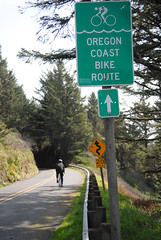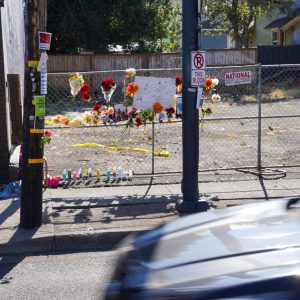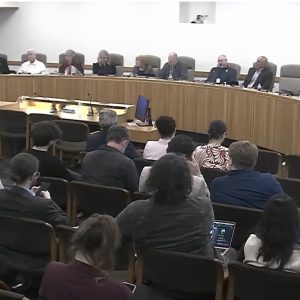
via Google Streetview.
The two Canadian women involved in a collision Monday on Highway 101 north of Gold Beach remain hospitalized at Sacred Heart Medical Center in Springfield (near Eugene) today.
30 year old Martha McClean remains in the Intensive Care Unit. That’s all I was able to find out about her condition after a call to the hospital today. McClean’s riding partner, 26-year-old Essya Mabrouka Nabbali, is listed in fair condition and one of her nurses told me she’s “stable” and “coming along.” The nurse also said Nabbali’s family is by her side.

Coast Bike Route are serene;
most of it is along
high-speed roads
with narrow shoulders.
(Photo © J. Maus)
Also since Monday, a woman that arrived on the scene just seconds after the collision occurred has come forward. Mary Matzek was a passenger in a motorhome traveling just behind McClean and Nabbali. Matzek wrote about what she saw and shared photographs of the scene on her personal blog (warning: the images are graphic and may be upsetting).
Matzek has also left several comments on our article about the collision.
This collision underscores what some people feel are inadequate bicycling conditions on the Oregon Coast Bicycle Route. The route is extremely popular with bike tourists from all over the world and it’s officially signed and designated by the State of Oregon as a scenic bicycle route.
While some segments of the route are off the main highway, most of it puts bicycle traffic on narrow shoulders just feet away from high-speed auto, truck, and RV traffic with only a strip of paint for protection.
In the case of this recent collision, it appears that the operator of the automobile hit the women from behind while they rode in the shoulder. The Oregon State Police have not released any updated information about their investigation into the crash. I left a message with Lt. Gregg Hastings today and have not heard back.





Thanks for reading.
BikePortland has served this community with independent community journalism since 2005. We rely on subscriptions from readers like you to survive. Your financial support is vital in keeping this valuable resource alive and well.
Please subscribe today to strengthen and expand our work.
If the route is marketed as a bike route and people die, whose fault is it?
I say it’s the people who push it in order to attract tourism dollars, and why I won’t ride such a stretch.
It’s the fault of the people that kill them.
It’s sort of the same problem I see with the push to get people to ride their bikes to work on Swan Island. It’s an extremely dangerous place to be riding a bike but people are continually urged to ride down there. And many do, including myself but I always breathe a sigh of relief getting off that island. Just because you *can* ride a bike somewhere doesn’t always mean you should.
OK you should ride your bike anywhere it’s legal and you have need to go there. If you’re working on Swan Island then you need to go there, you should ride your bike there. If it’s not safe it isn’t because bicycles aren’t safe, it’s because the cars around bicycles aren’t safe.
I hate to keep harping on the rape analogy, but if it isn’t safe for a woman to go to the park the answer isn’t to stay away from the park the answer is to make the park safe for a woman to go there. If the roads aren’t safe for bicycles the answer isn’t to keep away from the road on your bicycle but to make the roads safe for bicycles.
I will refrain from the rant on motor vehicles taking over the roads…
I’ve ridden from lincoln city to San Francisco. The only close encounters I had were of my own creating. Overall I felt safe very safe on the route. It was well signed, the infastructure makes bike touring a breeze, the campgrounds are amazing, free hot showers, coffee in every town… I want to do it again! That was my first solo bike tour and since then travel by bike has been my favorite way to see the country. If you’re not comfortable with traffic don’t ride it. Could I have been killed yes, could I get hit just as easily in a bike lane in PDX, yes.
Near Confusion Hill in CA I was grinding up a huge hill, no real shoulder and this car passes quickly and pulls over into a turnout. I thought we were going to fight from the way they pulled over, but the guy jumps out of the car, runs to the back of the car, opens his cooler and hands me an ice cold water as i ride by – awesome!
That’s nice.
I’m guessing the Canadian women aren’t really keen on feeling safe in traffic any more.
Was the driver on the shoulder?
Um, from the pictures and witness statements in the article and from the blog, it CLEARLY shows that the driver is at fault. Hitting a cyclist that was on the shoulder. … was probably on his cell phone and not paying attention!
From the story above…
In the case of this recent collision, it appears that the operator of the automobile hit the women from behind while they rode in the shoulder.
Yes, but that is Maus’ interpretation. Regardless, as he wrote:
“collision underscores what some people feel are inadequate bicycling conditions on the Oregon Coast Bicycle Route. The route is extremely popular with bike tourists from all over the world and it’s officially signed and designated by the State of Oregon as a scenic bicycle route.
While some segments of the route are off the main highway, most of it puts bicycle traffic on narrow shoulders just feet away from high-speed auto, truck, and RV traffic without only a strip of paint for protection.”
It’s too narrow, too fast, too many RVs with too many scenic distractions. Just a recipe for disaster.
Any organization that places a rider and driver in this situation is culpable. Not excusing the driver necessarily; errors happen.
I agree. The speed limit needs to be lowered. If motorists aren’t capable of driving safely after that, then perhaps the route needs to be blocked off from cars.
randall, since there are not several accidents there on a daily basis, it appears nearly all motorists negotiate it safely.
Thankfully, like the Momentum Magazine gentleman that wiped out on the Esplanade a while back, they are Canadians and have a humane health care system. When my son ran into a parked Porsche last year on his bicycle, he incurred a 30-40K med bill for a hosp visit of 3 days. No insurance, standard minimum wage job. Guess I’ll be participating & supporting REAL change @ Waterfront park this week!
Ok, assuming the driver is at fault. What next – widen the shoulder? That would assume the roadway is too narrow for safe multi-modal travel.
Ban RVs
Why? because you don’t like them?
On my longest bike trip–1,000 miles to Glacier Nat’l Park in 1993–RV drivers were the most predictably unpredictable. They often had no idea how large their vehicles were, did not share the road at all well, and were generally much scarier than semi trucks, pickups, and all the other categories of automobility out there on the open roads. Nothing malicious. Just not safe to be around.
I agree with this.
Having driven an RV I also find them very sloppy and keeping them in a straight line requires a lot of attention. Kind of like driving the oldest, crappiest UHaul on the lot.
This isn’t an attempt to absolve the driver of blame, just a data point.
Driver who hit the cyclists was in a PT cruiser. The blogger was in an RV following a couple cars behind.
No where does it say that the ladies were hit by someone driving an RV.
The witness accounts and tire marks indicate a car– so I guess by your logic we should ban all cars of whatever model. Or ban drivers who fall into the same characteristics as the driver who hit the women.
“ban drivers who fall into the same characteristics as the driver who hit the women.”
reckless? inattentive? distracted?
lower speed limits might be easier to enforce.
Reduce speed limits to 35mph
Teach Americans to drive would be my first suggestion for making the roads safer for everyone.
We need to reconsider the assumption that there should be two bike lanes one on each side of the road for each direction. A single bicycle path separated from the roadway by a guardrail for safety would be no wider than two normal bike lanes. This alternative would not only be safer, it would be more cost effective an have less of an impact on auto traffic which would earn support from motorists.
Right now however the hard shoulders do double duty as emergency stopping for broken down vehicles as well as bike lanes.
I rode the entire Oregon coast bike route recently and found one section that has what you described – a separated two-way bike path beside the roadway. I didn’t use it, and stuck to the busy roadway, probably to the annoyance of motorists, because it is not a good design. It puts cyclists in a spot where motorists don’t see them and creates many unnecessary intersections. For example the bike route had stop signs every couple hundred yards, where if you stuck on the roadway you can travel non stop. If you are travelling long distances on a bicycle it makes a big difference!
Even a separation is not enough to save cyclists (or pedestrians for that matter) from a motorist who is drunk, asleep, or otherwise distracted. Out of control vehicles can and do land on sidewalks. There needs to be a stronger deterrence from inattentive motoring.
Seeing how quickly these comments turn to ideology is disgusting. I pray these two girls come out of this OK!
When are we supposed to talk about how to theoretically fix a problem? No one wishes the girls to not be well, get over it.
Maus’ blog is widely read; maybe someone will listen.
Fix problems, or throw blame? Not that 101’s my favoritest ride (I’ve done it top to bottom), but these girls could have just as easily been hit by an inattentive driver in a wide bike lane in Portland – we don’t know what happened here. See other comments for a good suggestion of putting the actual bike lanes on the outside of the guardrails there with periodic access. While our government’s currently in the business of paying to boost the economy, seems like a better use of my money than $85B+ in an insurance company I don’t get shares to vote in return (taxation w/out representation).
Also, people tend not to ride bike tours without first looking into details, regardless of pretty pictures. And I disagree with your assessment it’s “extremely narrow.” How much of it have you cycled?
These girls weren’t hit by marketing, they were hit by a guy driving a PT Cruiser, and I’ll get over it when people on bikes stop getting hit from behind.
I didn’t know this was a “how narrow art thou” contest.
Your argument is a bit reductionist but I’ll play: to your point yes people do research, but how can they do it on every point along the coast?
The point is there are vulnerable users, some of whom got run over because the margin for error is quite small there.
I like the idea of putting a path on the other side of the rail. I’m sure it would lead to much more cycling, though someone has to pay for it.
Sorry for the greedy reductionism and thanks for your reply; I don’t think we really disagree on anything.
And I ain’t as ‘narrow’ as I used to be… 🙂
book the driver simple you run ppl over in the bike lane eff, whats wrong?
we are all road users!!! some just can’t share it safely.. I wish them godspeed. get well.
Thanks for following up, Jonathan, and Mary for your detailed and thoughtful account.
In this case based on what we think we know (section of highway is straight, visibility was quite good, two women were riding on the shoulder, etc.) the idea that the hwy dept. or other state agency is at fault here is ridiculous. I don’t think the fault of the driver is likely in question. Candice Palmer who ran over Reese Wilson in broad daylight was I think also recognized to be at fault: http://tinyurl.com/3el63qe but the grand jury found her “actions did not rise to the level of recklessness required to find criminal wrongdoing.”
The more interesting question to me in this case is what charges will be filed and what sort of justice and/or restitution the two women can expect.
I’d say that we all get to decide for ourselves the trade-offs between risk and reward. In my opinion the immense reward of riding the Oregon coast far outweighs the very small risk. If you disagree I doubt advertising is going to change your mind.
Sorry, that was supposed to be in reply to Jim’s first comment.
You mean promoting cycling on an extremely narrow, high speed, well trafficked road is responsible? That’s ridiculous.
I think you mean “allowing high-speed driving on a well-known, well-marked cyclist route is irresponsible” and I agree. The speed limit needs to be lowered, at least to 35, and probably to 25.
No I meant promoting it as the Oregon Coast Bicycle Route. A cyclist from Canada has no idea how dangerous parts of it can be. To promote a dangerous stretch so the route can be contiguous is irresponsible.
Jim,
you seem pretty committed to this idea that Hwy 101 is especially dangerous for visiting cyclists. I’m curious if you are willing to differentiate between
‘seems dangerous because there is often a narrow shoulder, it is curvy and people with RVs drive it disproportionately,’ and
‘actual (comparative) statistics on the dangers experienced by cyclists on Hwy 101?’
From others’ comments here I get the impression that it is mostly the former. I know that is how I think of it.
Thousands of people ride the coastal route every year. Matter of fact, many of the people I talk to who’ve done the whole thing, said the Oregon section was their favorite. There are some hairier spots (Lincoln City, ugh) but most of it isn’t any different than riding a busy road on *any* bike tour–you’re riding in the shoulder.
If it’s irresponsible to promote cycle touring the coast, it’s irresponsible to promote bicycle touring in 90% of the country.
Collisions are tragic, and I certainly hope I never get hit, but they’re fairly rare.
April, you are black and whiting the issue when there’s a large area of grey for improvement.
For instance, signage for bikes and cars would be cheap and do at least a little alerting. Verbiage in guide books or web sites can caution riders on particularly windy, narrow and/or trafficked spots. Verbiage can also alert a rider to the typical kinds of drivers on certain routes, as in a particular scenic spot with migrating whales off the coast can cause major distractions. Or point out things like a particular stretch of coast tends to be shrouded in fog, etc.
The best resources have this kind of information; the rider can then make an educated guess as to whether he/she is willing to risk it.
Yes, thousands of people tour and do charity rides; in fact I think you’d be surprised how many who do the latter suffer from accidents, either solo or with a vehicle.
There’s a well-known book about touring the Pacific Coast that *does* tend to point out the less pleasant places on the route. In addition, many touring cyclists share information on forums run by Adventure Cycling as well as bikeforums.net.
My point, though, is that most bicycle touring is on the shoulders of roads with varying levels of motor vehicle traffic. I just finished (as in, I got home yesterday) 4,000 miles of touring, and yes, plenty of it was highway shoulders. There were places where my boyfriend and I decided it was too dangerous to ride and hitch-hiked instead (Manitoba did not take cyclists into account when building highways). But mostly we took our chances and we were fine.
I’ve biked a few days on the Oregon coast and for most of it I felt safer than I do on, say, SE 12th during rush hour.
My point (I swear I have one) is that biking the coast isn’t any more dangerous than touring anywhere else. I’m not denying that we should do our reasonable best to make it safer. But I think it’s a reach to say that we shouldn’t promote bicycle touring the coast, unless you also think we shouldn’t promote bicycle touring at all.
You are responding as if you didn’t read my reply.
I agree with the gist of Jim’s point. Whenever I ride, I assess the risk of the road that I am on. If it has a narrow shoulder and high-speed car traffic, I realize that statistically I have a higher risk of getting hit. It only takes a small wobble by me or the driver (or both) for me to get hit. Might not even be anybody’s ‘fault’ legally, it just happens. I stay off of roads that I evaluate with just too long of odds against me. So, promoting bike riding on a road with bad odds is a bad idea. And, we are not going to get the speed limit drastically lowered on an important road like the coast highway.
(1) a road that feels unsafe and one that is unsafe (statistically) are not necessarily the same thing.
(2) you can be sure that folks in 1974 also couldn’t imagine a 55mph basic speed rule coming to town.
I’ve biked the Oregon Coast. What bothered me was not the speed or proximity of cars, but the sheer amount of them.
Best wishes to these two ladies, hope they are up (and on the bike) again soon.
I’m not going to parse out language.
The only thing I know is: two people died on a road I’ve driven and wouldn’t feel comfortable riding on.
“The only thing I know is: two people died on a road I’ve driven and wouldn’t feel comfortable riding on.”
Dude, that is true for many many many streets in Portland. Have you heard of ghost bikes?
Are we reading the same blog? The two Canadian women were injured, one it sounds like very seriously, but neither has as far as I know died.
Oops, mea culpa on that.
Dude, dangerous is dangerous. Plenty of blame to go around, but the riders were there for a reason: they heard it was a great spot to ride.
It *is* a great spot to ride. Two of the best days of my life were spent cycle touring from Cape Lookout to Newport. I can’t wait to do it again.
Hmmmm… So we have the problems at Skyline and we have the problems going towards the coast. It seems that we need to come up with a better system for bicycling on non-urban roads. Perhaps we could use the bikeways metaphor and turn smaller roads in the long-distance bikeways with low speed limits and closed to oversized vehicles.
Having ridden the entire Oregon coast by bike, I was impressed with how much room I did have to ride. True, there are some stretches where there is a narrower shoulder, but, overall, it’s not too bad. California’s Highway 101 and 1? I didn’t feel safe.
I agree with SilkySlim–LOTS of cars on the highway, some of whom are driving too fast and too inattentively. It doesn’t take much for someone to go over that white line on the shoulder and hit someone or something.
My best wishes to these ladies and their families.
Jim,
Either you are a car driver and like to start things here or you are just playing devils advocate. Just don’t see how you can even begin to side with the driver. Sure the road might be narrow and fast, but the shoulder is not where a car should be driving. There were two women were hit by a car while riding correctly on a road. Facts are facts. If you drive like an idiot, you will endanger everyone else on the road.
If I were these two women, if the driver is not found at fault, I would sue him for personal damages. This seems like an open and shut case, but the driver may have enough money to find an attorney that will get him off.
One Less, you’re not reading my comments correctly.
Yes, I drive. Yes, I’ve ridden a bike on and off for decades, both as a racer and a transpo cyclist.
It does appear the driver is at fault here, but as others have said it is still a dangerous situation and little errors can maim others.
My point isn’t about how much the driver should be punished, but to look at what happened and how it could be prevented in the future. To punish a driver severely now doesn’t hinder a different driver years from now.
All users should feel safe on this road, designated as a cycle route. I’ve driven this and seen cyclists on the shoulder and thought, “I’m way too close to them and I’m towards the center line.”
I think the problem is that drivers don’t have much to lose when they hit a cyclist so they don’t pay that much attention when they pass. There is nothing we can do about the physics of the situation, the only thing we can change is the legalities. I’m in favor of “Hit a vulnerable road user, lose your vehicle” as the law, with “Kill a vulnerable road user, lose your license for life” as an escalation. To make that stiffer make driving without a license the same as illegal possession of a weapon, a major felony with major jail or prison time. That at least balances the potential ramifications a little.
Any updates on this case? What ever happened to the investigation of the driver?
I just rode most of the Oregon Coast highway last month. In most places the shoulder is not narrow, and it doesn’t seem that dangerous. There are a few places where that is not the case. Ironically, the place where these two ladies were hit is not one of the ‘dangerous’ ones. If they were indeed on the shoulder, it is totally ridiculous not to blame the driver.
Getting a driver’s license is just too easy. When I renewed mine last month I thought the process was too easy.
Best wishes for a full recovery to these two women.